RIGHT TURN ONLY!!
Perfect TenTen
by Carlo Santos,

What? Less than two weeks to Anime Expo?! People ask each other, "Are you ready for the con?" In a way, I don't think anyone is ever truly "ready" for a con. Con is something that just happens ... and it's up to you to make something of it.
Enjoy the Miku show, everyone.
AMNESIA LABYRINTH
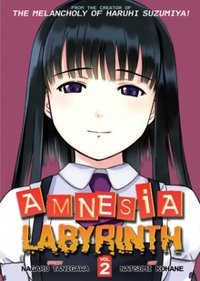
Vol. 2
(by Nagaru Tanigawa and Natsumi Kohane, Seven Seas, $10.99)
FROM THE BACK COVER:
"With the police no closer to finding the killer responsible for the murders of three high school students, Souji Kushiki and his plucky girlfriend Yukako continue down their own path of investigation. While Yukako seems to hit a dead end in her detective work, Souji has his own disturbing suspicions. He's narrowed down the list of suspects to just a handful of people: his family!
Could one of his clingy, obsessive younger sisters really be the killer? Or could the dark truth go deeper than Souji imagined? Whatever the answer, someone else will soon die and Souji's world will be rocked to the core!"
EVIDENCE FOR:
As usual, the truths of Amnesia Labyrinth are left as an exercise to the reader, but instead of pointless ramblings, this time we get are some pretty hefty conclusions. Not that Nagaru Tanigawa would ever state those conclusions specifically—that would be too easy—but anyone paying attention can definitely piece it together. The storyline drifts sneakily between dreams, flashbacks and reality, sometimes even presenting certain scenes as fake when they turn out to be real (or vice versa). But it's not just logic puzzles that make the story work, but the overall atmosphere: many of the scenes involve long silences, where the things unsaid between characters make it far more intriguing than any dialogue could have. And don't forget the contrast between the quiet, delicately illustrated town that Souji lives in, and the shocking activities that are really going on there. Artist Natsumi Kohane also takes on a challenge in the later chapters, using lots of hatched lines and ominous shading to create a different era where a supernatural back-story adds new layers to the series. One part of the puzzle may be solved, but new mysteries appear.
EVIDENCE AGAINST:
Now that actual answers are starting to show up, a lack of plot is no longer the weakest point of the series. Rather, it's the way the plot is presented, with clumsy transitions between different scenes. Of course, some of them are meant to be deceptive, but there are times when it's obviously just a basic shift from one time and place to another—yet the lack of a good stopping point, or a decent establishing shot for the next scene, causes it to fall apart. Sometimes it's even the scenes themselves that hurt the storyline; certain moments seem to be just filler incidents where the characters chat pointlessly with each other (or not at all). Meanwhile, the parts of the story that are relevant might set off various cliché detectors: how convenient that certain psychological disorders always seem to crop up as plot devices in mysteries like this. Kohane's art is also a stumbling block at times, showing inconsistency when it comes to basic character design and anatomy (just look at that one awkward kiss scene early on). Seriously, get the faces right first, then worry about fancy hatching and pretty backgrounds later.
FINAL VERDICT:
Certainly not as maddening and pointless as the first volume, and there's a rewarding feeling in realizing what's going on. Although still clumsy at times, it improves to a B-.
BAKUMAN
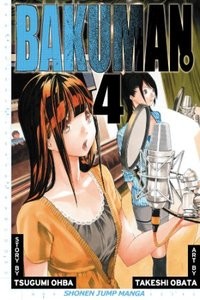
Vol. 4
(by Tsugumi Ohba and Takeshi Obata, Viz Media, $9.99)
FROM THE BACK COVER:
"Average student Moritaka Mashiro enjoys drawing for fun. When his classmate and aspiring writer Akito Takagi discovers his talent, he begs Moritaka to team up with him as a manga-creating duo. But what exactly does it take to make it in the manga-publishing world?
When Akito is unable to come up with a storyboard within the time frame he promised, Moritaka decides to break up their partnership! As they go their separate ways to create manga, it may turn out that they're actually headed in the same direction..."
EVIDENCE FOR:
As this volume of Bakuman cleverly shows, the biggest creative block is sometimes not a lack of ideas, but a lack of communication. It's a problem that Mashiro and Takagi's editor solves in amusingly roundabout fashion ... but then leads to the two turning the tables on him. It's classic Death Note-like mind games and suspense, except in the world of manga. After that comes a more typical "battle" arc, but still filled with excitement and drive, as Mashiro and Takagi enter another contest with hopes of getting serialized. What really sparks this storyline is the variety of entrants: high school prodigies relying on sheer guts and determination, a longtime assistant hoping for his big break, a trash-talking twentysomething firebrand, even the kooky glam-rocker who decides to start drawing for fun. Obata's striking character designs and detailed lines bring all of them to life, and even more impressively, he shifts styles in art when displaying each of their contest entries. But ultimately, the real high point of this volume is the editors' meeting near the end—a realistic, complex look into how the industry works, with a final result as dramatic as any superpowered battle.
EVIDENCE AGAINST:
Maybe manga fans don't need a complex look into the industry—especially if it means sitting through a transcript of a business meeting. Once again, this series suffers from walls of text streaming down almost every page. Even an eye-catching moment, like the boys getting an important phone call, is usually marred by wordy dialogue bubbles. So imagine how tedious it must get when the Jump editors start critiquing the latest submissions, turning this into more of a how-to manual than visual entertainment. This also leaves little room for the actual characters to develop in any way. Aside from that amusing little hiccup in their partnership, Mashiro and Takagi often seem like dull, manga-creating robots that are just there to prop up Ohba's text. And Azuki, the love of Mashiro's life, is so passive—and the "romance" between them so contrived—that most scenes involving her end up being a waste. The stereotypical side characters are equally bad: sure, there's some variety in having a shojo-manga-pedigreed writer and charismatic rocker-turned-artist, but do they interact with the main cast in any meaningful way? If not, then they're basically useless decorations.
FINAL VERDICT:
Although it offers lots of insights about the manga business, and has its emotional highs and lows, the flat characters and overloaded dialogue land it at C+.
BLEACH
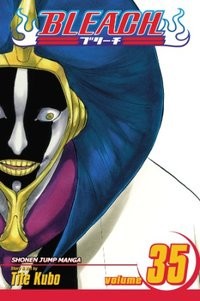
Vol. 35
(by Tite Kubo, Viz Media, $9.99)
FROM THE BACK COVER:
"Ichigo 'Strawberry' Kurosaki never asked for the ability to see ghosts—he was born with the gift. When his family is attacked by Hollows—a malevolent lost soul—Ichigo becomes a Soul Reaper, dedicating his life to protecting the innocent and helping the tortured spirits themselves find peace.
While the Soul Reapers are entrenched in bloody one-on-one battles with the Espadas, their sworn enemy Aizen is preparing to make the next move in his elaborate plan. The battlefields of Hueco Mundo will soon give way to another battlefield where the price of losing will prove to be infinitely higher."
EVIDENCE FOR:
The obvious centerpiece of Bleach's 35th volume is a loud, brute-force battle between bloodthirsty shinigami Kenpachi and scythe-wielding Nnoitra. It's got all the expected elements of a classic brawl: the surprise power-ups, the near-death comebacks, the refusal to back down until the combatants have given it their all (and then some). But Tite Kubo infuses it with such energy and stylishness that it stands apart from other fighting manga: just look at the madness in Nnoitra and Kenpachi's eyes, the perfectly curved rivers of blood gushing from their wounds, and the sharp angles that frame each clash of their blades. Amidst the savagery, however, also lies a cinematic beauty, with dramatic pauses and close-ups that almost resemble ballet rather than battle. The series has other facets to it as well: a touch of humor as Ishida and company pick up the pieces of the scientists' battle between Mayuri and Szayel Aporro, and a dramatic turn of plot when Aizen makes his next move in the closing chapter. Just when you think you're going to get tired of the fighting, a new wrinkle always emerges.
EVIDENCE AGAINST:
While the Kenpachi-Nnoitra showdown may indeed be loaded with intensity and nonstop visual treats, it also reveals why "doing something familiar and doing it well" isn't always enough. Too often the fight devolves into panel after panel of swords bouncing off each other, leaving readers to wonder why it takes 15 pages or something to express the same repeating sequence. That repetitiveness applies not just to tactics, but to the battle as a whole, where every time someone takes a fatal blow, he inevitably says, "I'm not dead yet!" and goes back to screaming and swinging away. Yes, we get it, these guys are really strong—and it could have been over in half the time if Kubo didn't keep belaboring the point. The shallow storyline is a problem as well: a sudden flashback about Nnoitra's past feels forced and does little to add depth to his character. Is there really need to know anything about him other than that he loves to fight? Similarly, we already knew the maneuver Aizen was planning, and at this point it looks like an excuse to keep the endless, repetitive battles coming.
FINAL VERDICT:
Between the lack of story depth and the bland nature of this volume's central fight, it's hard to give this anything higher than a C, even with the masterfully drawn action scenes.
SHUGO CHARA!
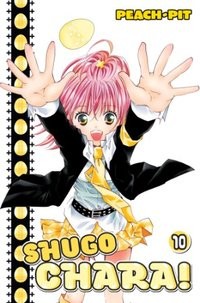
Vol. 10
(by Peach-Pit, Kodansha Comics, $10.99)
FROM THE BACK COVER:
"As Amu and Ikuto get to the heart of the Easter Corporation, the Embryo's true owner is found, and the egg from Ikuto's violin resurfaces! Later, as graduation approaches, relationships complicate. Who will prove the victor in this game of hearts?"
EVIDENCE FOR:
Madoka Magica may have stolen away the magical-girl buzz from Shugo Chara!, but there are still areas where this series reigns supreme. Few artists can match Peach-Pit's nuanced visual style, where delicate lines, soft shading, and sparkling effects add a layer of charm to every scene. Add in the flower patterns and freeform panels, and it's clear that this is truly a magical-girl series for girls instead of just an action series with magical-girl elements. The story, meanwhile, reaches new emotional depths as the Easter saga closes out; once again it's not fantastic combat and transformations that save the day, but the pureness of Amu's heart facing the final villain. That's her real power: to take a shallow, unlikable character, and in a single chapter, break down his walls to reveal him as the flawed, sympathetic figure he truly is. It's a true tearjerker moment, and the heartstring-tugging doesn't stop there. Later Amu finds herself dealing with graduation, other characters moving on (don't worry, Ikuto fans will finally witness the moment they've been waiting for), and the many changes that make life unpredictable. Still, nothing's quite as unpredictable as the cliffhanger that ends this volume...
EVIDENCE AGAINST:
If there's such a thing as wrapping up a story arc too neatly, it might be the way everything miraculously falls into place here. The big bad boss of the Easter Corporation never seems all that menacing in the first place—just a shallow, plastic brat waiting to be knocked down by Amu so that she can be declared the winner. Even the big emotional turning point relies on a flimsy plot device to succeed, with the mysterious and dashing Tsukasa appearing out of nowhere to narrate a critical flashback scene. Seriously, how'd he get into a securely guarded corporate building? Even the love triangle that made Amu's romantic life so interesting suddenly settles down, thanks to one of the boys backing out and everyone calling truce. It really feels as if Peach-Pit wanted to resolve all the dangling plot lines, but did so in a quick and dirty way instead of thinking things through. "Quick and dirty" might also describe the artwork at times, with a few too many chibi gags and stiffly drawn backgrounds standing out like sore thumbs against the delicate visuals.
FINAL VERDICT:
This one really strikes close to the heart, and does it in eye-pleasing fashion as well. Score a B+ for this magical adventure where the real magic is not in fancy transformations, but in one's honest feelings.
TENJO TENGE

Vol. 1
(by Oh!great, Viz Media, $17.99)
FROM THE BACK COVER:
"Soichiro Nagi and Bob Makihara were always the meanest street brawlers around. When they enter Todo High they plan on carving out a reputation as the strongest fighters in their new school—easier said than done in a place that's dedicated to training its students in the art of combat! After realizing they're the new fish swimming in a tank full of sharks, Soichiro and Bob enter the Juken fight club as rookie members. However, the Executive Council—the archrival of the Juken Club—soon launches a surprise attack. Soichiro and Bob have a chance to show their stuff, as long as they don't get curb-kicked in the process!"
EVIDENCE FOR:
The dream is now reality: Tenjo Tenge. Uncensored. In English. As expected, this martial arts brawler brings equal amounts of mind-blowing action and mind-blowing fanservice. Right from the first chapter, the fight scenes come alive with ridiculous ki-powered punches and the unapologetic smashing of walls and windows. A variety of characters and fighting styles, coupled with dramatic angles and unusual settings (a women's bathroom), make each battle interesting in its own way. Visual stimulation also comes in the form of the series' bosomy heroines, and somehow, the topless scenes and panty-flashes manage to flow with the action rather than stopping it and being a distraction. The real heart of the story, however, is in the dynamics between the characters. When the fists aren't flying, it's the relationships that keep the pages turning: Soichiro and Bob's initial antagonism towards everyone morphing into an alliance with the Juken Club, the love triangle between Soichiro and sisters Maya and Aya Natsume, and the consuming desire for vengeance after the Executive Council commits an unspeakable act. It's a thrill to watch everyone fight, but it's an even greater thrill knowing why they fight.
EVIDENCE AGAINST:
Just because the author can spit out an answer as to why the characters fight, doesn't necessarily make it a good reason. Sadly, Tenjo Tenge is riddled with the usual brawler clichés, with the heroes declaring that they want to get stronger and rambling on about what "being strong" really means. Look, nobody reads this genre for intellectual stimulation, so don't bother trying to fake it. Even the attempts at emotional content fall pretty flat, with the Soichiro-Aya romantic angle emerging from a paper-thin premise ("from the moment I saw him, I knew we were destined for each other!") and the resulting rivalry with Maya feeling even more contrived. (They were training together, and now you're jealous? Get a grip...) However, it's the overall story structure so far that may be the series' greatest weak spot: a good fighting series should give the reader a rough idea of the power structure and how the hero will be battling increasingly difficult opponents, but here it feels like a crowd of random tough guys all going after the Juken Club. Without a sense of upward progress, this series will soon be headed nowhere.
FINAL VERDICT:
It's painfully average when it comes to story content and having characters worth caring about. But the vicious fight scenes are a plus, so it picks up a C+.
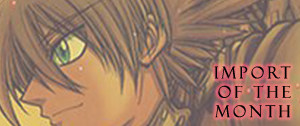
SEKAI ICHI HATSUKOI (World's Greatest First Love)

Vol. 1: The Case of Ritsu Onodera
(by Shungiku Nakamura, Kadokawa, ¥588)
FROM THE ENCYCLOPEDIA:
"Ritsu Onodera has just transferred from his father's publishing company to Marukawa Shoten. Assigned to the shoujo manga division, he crosses path with the person he'd least expected to meet. Masamune Takano is the editor-in-chief of the division Ritsu's been assigned to, and the two seem get off on the wrong foot right from the very start when Takano unexpectedly kisses him. However, there is more to than what meets the eye ... Takano is actually Saga, Ritsu's senpai and high school love—whom Ritsu had thought to have played him for a fool by taking his affections for granted when he confessed and summarily dumped him."
EVIDENCE FOR:
Well, this was supposed to come out in English this month, but the shutdown of Tokyopop and BLU has sent Sekai Ichi Hatsukoi back to the import shelf. Like any good boys' love series, it's an emotional rollercoaster ride packed with conflicting emotions ("I don't love him! But he gets me so worked up!"), strong back-and-forth dialogue, and kiss scenes that will leave readers quivering with delight. There's just something about the excitement of it being non-consensual, you know? But don't think this is all a tease—those who are patient will be rewarded with a graphic bedroom scene in the final chapter that carefully treads the line between sensual and squicky. Ritsu's intense up-and-down emotional journey is also helped by cleanly drawn panels and scenes that flow effortlessly from one moment to the next. Still, it's the additional dimensions of plot that really make this scandalous romance work, like the publishing-house setting that gives us an insider's look at the manga business. Nakamura definitely gets in a few humorous jabs at the industry, showing how a manga career is often less about deep artistic expression and more about churning out assembly-line artwork against incredibly tight deadlines.
EVIDENCE AGAINST:
Now what was that about assembly-line artwork? Just look at the main characters here and you might as well be looking at any contemporary BL series. While it's understandable that there are certain rules to character design in this genre, you can't get much blander than Ritsu's boyish, light-haired appearance and Masamune's mature, long-chinned face. And don't even get started on side characters like Yokozawa, who is basically another lookalike seme type with slightly different hair. Background art can be lazy as well, with a few too many scenes consisting of white space behind the characters, or worse yet, entire panels consisting of nothing but dialogue bubbles. (To say nothing of Ritsu's monologues where he argues with himself over his feelings, thus wasting valuable page space.) From an overall perspective, though, the biggest problem facing this series is the sheer unbelievability of certain scenarios. It begins all the way from the back-story, where Ritsu's naïve confession of love somehow leads to instant lovemaking, and moves on to ridiculous coincidences where the main characters reunite at the same workplace after ten years and live in next-door apartments. Well, boys' love is all about impossible fantasy, isn't it?
FINAL VERDICT:
The story has obvious holes in it because of the way the genre works, and the artwork is passable at best. But as a pure emotional thrill ride, this is sure to set one's heart aflutter (and maybe other bodily organs too).

You know what hasn't made its way into RTO lately? Yuri! Well, I'm about to fix that with Steven Huynh's review of a quality series that ought to be on every fan's radar.
Don't forget, you can also help spread the gospel of yuri (or yaoi, or moe, or whatever else floats your boat) just by sending in your own reviews! Check out the details at the end of this column.
GIRL FRIENDS

(by Milk Morinaga, Futabasha, ¥630 ea.)
Yuri titles which portray lesbian relationships realistically and honestly are a rarity in both anime and manga, and it doesn't help that the genre is a very niche one itself. Titles which portray yuri in any kind of light usually only lightly hint at it, and ones which do contain yuri content are usually more interested in fan service and sappy melodrama. But what we have in Girl Friends is something much more meaningful and special than those kinds of series and you will soon see why.
The story begins by introducing Mariko Kumakura (or Mari as she is known by), a shy high schooler who succeeds when it comes to getting the top grades in her class, but fails when it comes to any kind of social life. However, she finds herself making friends with the beautiful and friendly Akiko Oohashi (her friends call her Akko), and the two quickly become good friends. But as time goes by, Mari soon finds herself developing a physical attraction toward Akko, causing her to question whether they are simply just friends or something more.
From the onset, many will likely feel alienated by the copious amounts of time dedicated to the girls and the time they spend shopping for clothes, putting on make up and doing many other girly things. But those with patience will find that at its heart, Girl Friends is an honest look at two girls who develop romantic feelings for one another, and the growing pains they experience in trying to be honest to both themselves and each other. Normally, a story of this nature would be exploited for cheap laughs or fan service, of which the manga does contain in small doses. But considering the intended demographic of the magazine it was published in, Comic High!, this isn't unexpected. What makes Girl Friends praiseworthy however is that it, for the most part, doesn't resort to such tactics. There are no cat girls/nurses or giant fighting robots, and the female characters aren't falling head over heels for each other in random fashion like dominoes. Instead, the focus is a serious look at Mari and Akko's budding relationship.
Both Mari and Akko experience very real and honest emotions throughout the story, and there is a distinct sense of realism and sincerity in the way they are portrayed. Mari has a real tough time accepting that her feelings may be more than just friendship because she assumes that her friend is heterosexual, harbouring a one-sided affection for much of the story as a result. As well, because of the pressures of her peers and society alike, she begins to feel that maybe she isn't normal and so she consistently tries to over compensate as she struggles with her feelings. Akko begins to develop similar feelings after some time, and isn't sure whether a relationship between them is possible, or if Mari even wants one for that matter. Despite wanting the same thing, their internal fear and lack of effective communication with each other causes them to quietly suffer alone, unintentionally hurting each other in the process. The hesitation and uncertainty our heroines go through is realistic enough for many readers to sympathize with and relate to, and it is hard not to appreciate the effort Morinaga takes in presenting Mari and Akko's developing romance with a genuine and earnest light.
Those who are looking for a yuri series that is serious about exploring lesbian relationships without cheap laughs or thrills will find Girl Friends an absolute delight. This is one which you could easily rank up there along with other yuri titles like Aoi Hana and Sasameki Koto. The ending is rather abrupt and being your typical happily ever after ending, it feels like a bit of a cop-out as more could have been said about Mari and Akko's relationship and the potential implications it could have later in life. Despite this, Morinaga explores their developing feelings with a kind of realism, honesty, and sincerity usually unheard of for yuri manga making this one worth reading, even for non-yuri fans.
Is there a hidden gem of manga you'd like to reveal to the world? Is there a piece of garbage that deserves to be bashed in public? Or is there a title that didn't get a fair grade here, and you want to set the record straight?
Now's YOUR chance to be the reviewer! Write a review of about 300-400 words (a little more or less is fine) and include:
- Your name
- Title of manga (and volume no., if applicable)
- Author/Artist
- Publisher
- Briefly describe the story, then explain why this manga is great, terrible, or in between. Be objective, but also be entertaining.
Then send it in to rtoreaders (at) gmail (dot) com (plain text format preferred). One review will be selected out of all the submissions and will be published in the next column. All types of manga and manga-inspired comickry are accepted, from past and present, from Japan and beyond—what matters is that it's the Reader's Choice! NOTE: Submissions may be edited for formatting and grammar.
discuss this in the forum (14 posts) |